Even though vacuum tubes are technology from the 30s and 40s, the best guitar amps today still use vacuum tubes despite the availability of more modern technology. Amps with vacuum tubes simply sound too good to be replaced by anything else as yet.
“How do tube amps work?” This lesson will take you back to the fundamentals of vacuum tube technology, the components and assembly of tube amplifiers, and everything else you need to know to use them even better.
Before we start poking around at the parts of a tube amplifier, we must sound a warning. Tube amps come from way back when everything was trying to kill you. Some of their internal components operate on several hundred volts (450 or more) and contain seriously lethal capacitors.
In other words, don’t touch anything inside your tube amplifier if you don’t know what you’re doing. With that, let’s start with an overview of vacuum tube technology.
Tube amps work because vacuum tubes have excellent audio characteristics. When it comes to amplifying signals, inverting their polarity, or splitting and mixing signals, vacuum tubes (also called valves) perform outstandingly well and add a unique personality to the result.
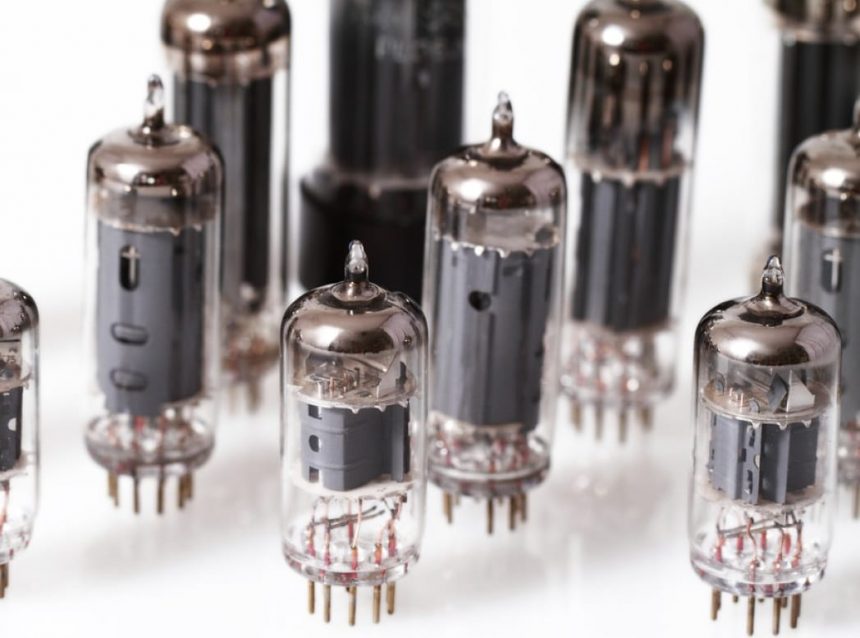
A vacuum tube is an electrical component made of a tube with the air sucked out and fitted with various electrical components inside. They work because electrons can travel through space in a vacuum, while they cannot do that easily through non-conductive air (it does happen when high voltage lines cause arcing).
The whole purpose of a vacuum tube is to control the flow of electrons. Some of the components you will find inside the tube include a cathode, heating element, grid, and plate.
The basic design of a vacuum tube hasn’t changed in over a century. They consist of a cathode (electron emitter), anode, grid (with the input signal), and a few more components depending on the desired purpose.
Here is a simplified diagram showing the internal components of a vacuum tube:
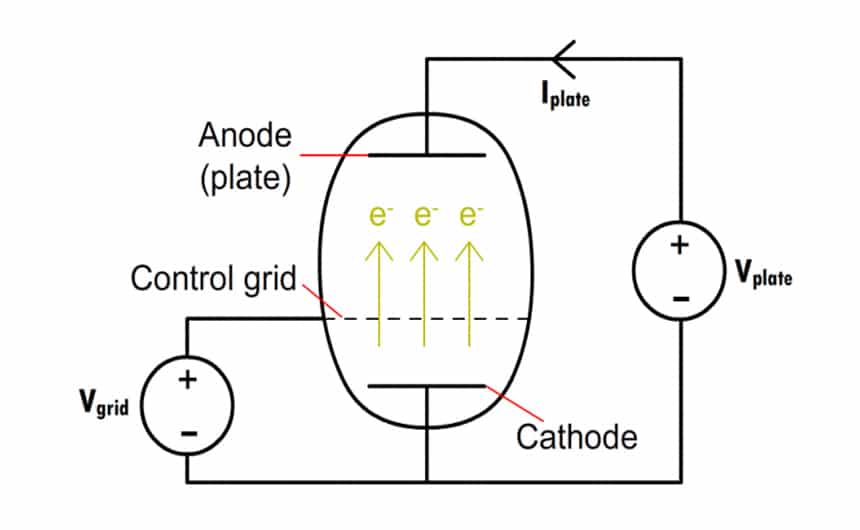
Here is a more detailed image of a vacuum tube showing the internal components. We will have a look at what each of these parts does in the assembly.
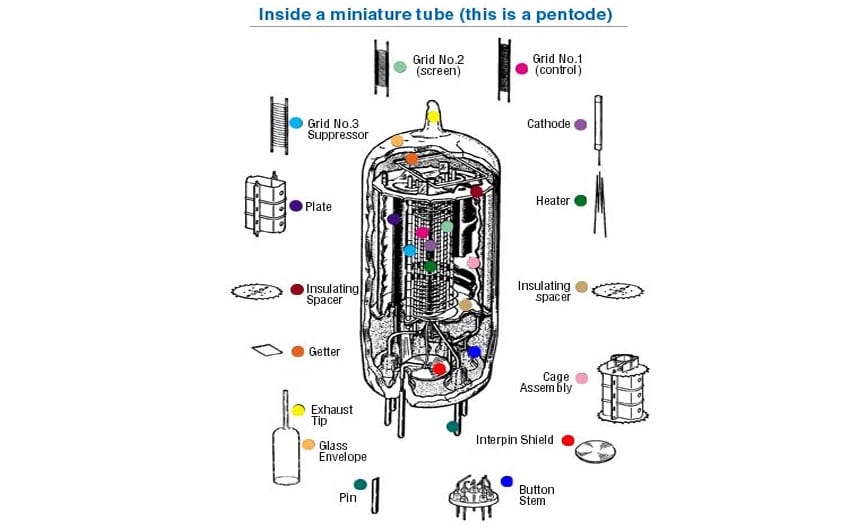
The added parts in this image are metal grills used to control the flow of electrons and reduce capacitance, thus improving the performance of the tube immensely.
The most basic design of a vacuum tube mainly consists of four
A cathode is a positively charged pole. It is an element with a slight positive charge located at the tube’s center and emits a stream of electrons (negative charge) in the right conditions. These electrons pass through the vacuum to a second plate with a stronger positive charge.
One of these “right conditions” is the presence of another plate with a much stronger positive charge (the anode). This difference in charge attracts a high flow of electrons because, unlike charges, it tends to attract. This flow can be used to manipulate a signal with the right control.
The second condition necessary to ensure the flow of electrons is heating. The cathode needs to be heated so that electrons can flow freely. The filament will be located next to the cathode in the center to facilitate this; alternatively, the element itself will be the cathode and coated with special material to provide the flow of electrons.
A high positive charge plate surrounds everything inside the vacuum tube. It works by attracting the negatively charged electrons towards itself inside the vacuum tube, which makes it the anode. It collects the electrons emitted by the cathode at the center and also picks up the signal from your guitar pickup.
So far, we haven’t discussed how the vacuum tube amplifies the signal from your guitar pickup. This is where things get really nifty.
A fourth component, called a grid, comes between the plate and the cathode. The grid is a piece of metal connected to the input from your guitar, which charges it and gives it a small positive or negative charge depending on the incoming signal.
This is why the cathode is not negatively charged but has a slightly positive charge. Without any current flowing in it, the grid will be negative by comparison, which helps to repel the electrons in the anode and keep them in place until a voltage is applied to attract them.
Obviously, this process is far more complex than this, but you can now understand the basic operation of a vacuum tube. There are other components in a tube amp that work together with the vacuum tubes to become the kind of amp loved by the best musicians everywhere.
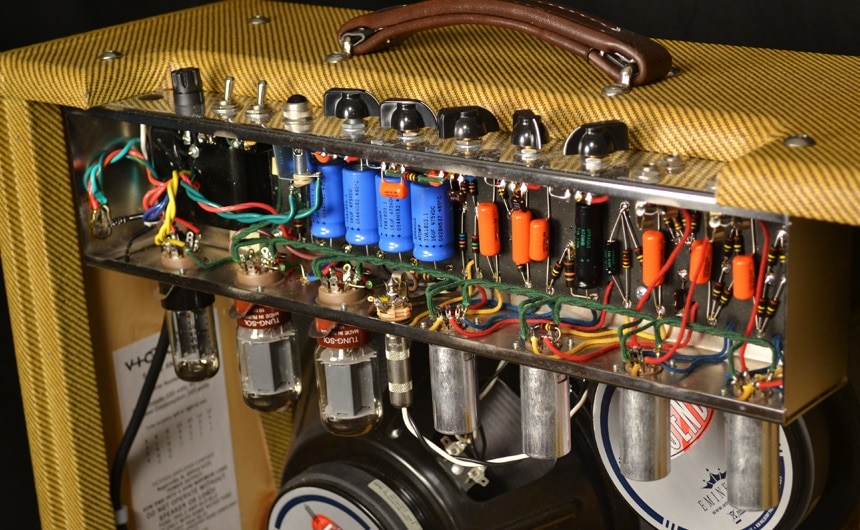
There are a few more principles of electricity that you have to understand that play a part in the operation of a tube amp as a whole. First, the relationship between current, voltage, and resistance is defined as:
V (voltage) = I (current) x R (resistance)
In other words, the voltage is the product of the current and resistance measured between the ends of a conductor or circuit. If you think of current as the amount of water flowing through a pipe, voltage is the pressure pushing the water, and any restriction to this flow causes resistance.
Secondly, mains electricity is supplied as alternative current (AC) that changes direction 50-60 times every second. This electricity comes in the form of a sine wave, but audio equipment such as tube amps operate on a steady DC current.
Thus, a tube amp will have a device to convert mains electricity from AC to DC, then a transformer steps it up and down as required to supply it at different voltages to the other components in the system. Let’s closely examine each of these components that make up a tube amplifier.
While the tubes in the circuit operate at over 200V, the elements in the valves require a 6.3V AC current to work. Thus, the first step is to step up or down the electricity supply as required and send it to the different circuits.
The rectifier valve converts (or rectifies) the AC signal from the supply to a DC signal that the tubes can use. This was also done in older amps using a tube (valve) rectifier, but silicone diodes have since replaced them in more modern equipment.
The different electrical waveforms look like this:
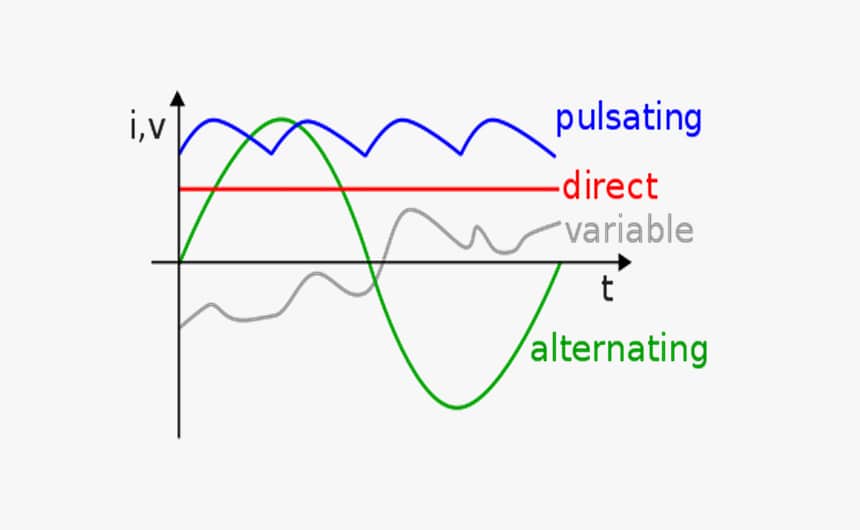
As you can see, an alternating current represented by the green line has a sinusoidal (up and down) waveform, while we need a more stable direct current. Because the waveform keeps changing direction, the rectifier corrects this reversal to produce a unidirectional waveform.
The rectified DC waveform is not completely straight. Instead, it tends to look more like the pulsating waveform above. Capacitors act like dams on a river, storing charge and releasing it more steadily and smoothing out the “ripples” in the flow.
These capacitors continue to store a lethal dose of charge even when the tube amp is switched off. Due to the high voltages involved, this charge can be lethal if you touch the wrong place and they dump this charge inside your body. That’s why only trained technicians should open up tube amps.
The high DC voltage produced by the capacitors then goes to the plates in the tubes, which require a high positive potential to attract electrons from the cathode. If further voltage or current regulation is required down the line, it is accomplished by using resistors.
Like a constriction in a pipe, resistors can be used to control and reduce the amount of voltage and current in a system. They dissipate electrical energy depending on their resistive value, whose units are ohms.
If you’re interested to know, older tube amps had more character and personality because they used older resistor technology. Carbon-comp resistors added “noise” to the system, which produced the vintage sound we know so well. Some modern manufacturers use “clean” metal film resistors with a truer signal but less character.
If you ever build your own tube amp or would like your technician to help you experiment a bit, you can always suggest changing the resistors in the output stages of the circuit.
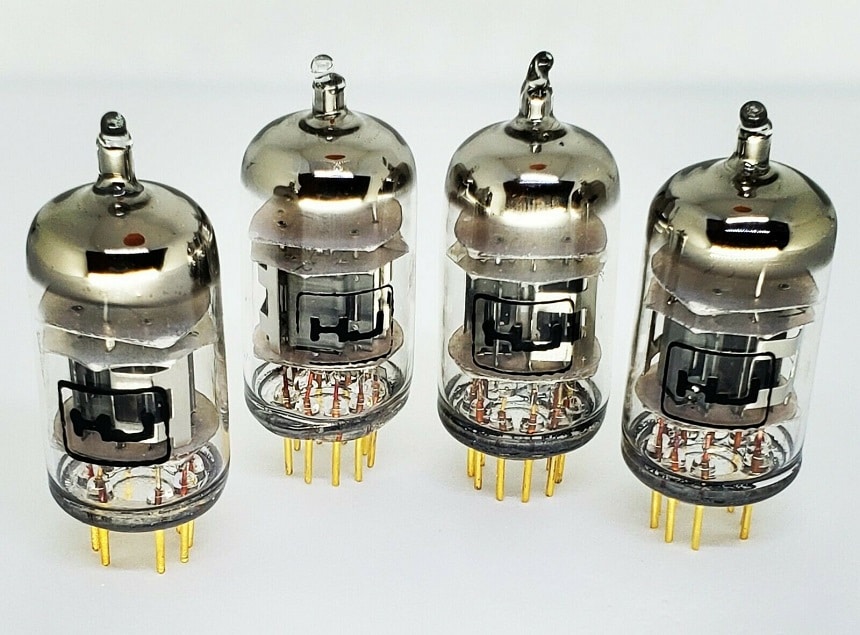
Many valve amplifiers have two sets of tubes: preamp tubes and power tubes. The preamp tubes are the first set that receives the guitar pickup signal. Their work is to pre-amplify the guitar signal to a level that can be applied on the larger power tubes, and they also drive reverb or tremolo effects.
The 12AX7 type of preamp tube is one of the most common. The 12 in the specification indicates the amount of heater voltage they take (as opposed to 6.3V), but different manufacturers make them in very different ways. The most common 12AX7 tubes have a gain factor of 100, making them one of the most powerful options.
The most important job of preamp tubes is to give character to the input signal. They add rich harmonics, create distortion, and add sustain to the sound at high volumes, known as overdriving the preamp.
Preamp tubes mostly contain the three parts described above: cathode, grid, and anode. This is known as a triode design.
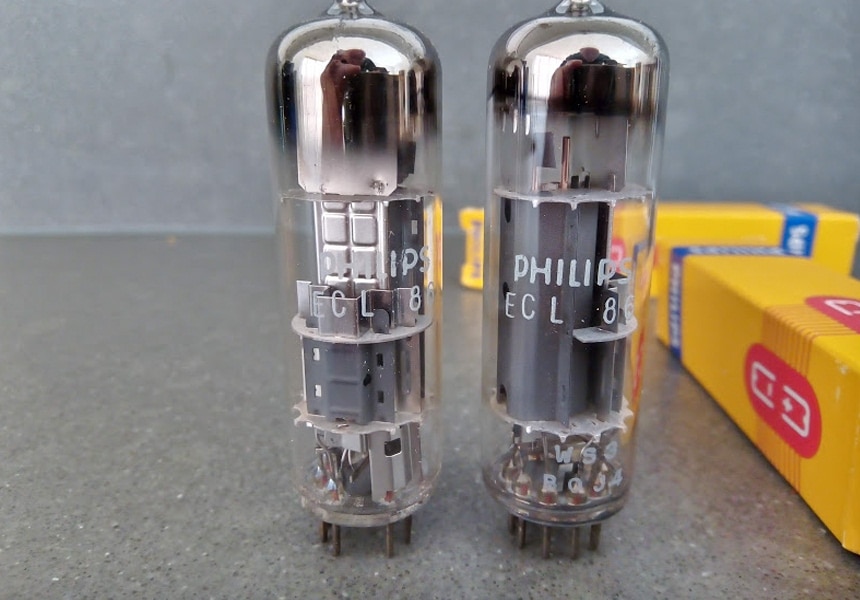
Power tubes are a much larger type of valve that amplifies the preamp signal to speaker levels. (on the other hand, preamps amplify signals to line level). They are usually five-part designs or pentodes, adding more screens to the three major components to help with electron flow control.
Examples of pentode power tubes are the EL84s and EL34s, whose performance is almost comparable to that of solid-state components. The master volume dials control the power tubes to vary the volume levels, but they don’t color the sound output as much as the preamp tubes.
However, be careful when swiping out the tubes. Never swap out hot tubes, and be careful to follow all manufacturer guidelines while doing so. Never force a tube in or out; always have a technician do this for you if the chassis (cover) must be removed to change the tubes.
One of the ways that tube amps can add color and texture to sound is through the use of a vibrato oscillator. Actually, the correct technical term is a tremolo oscillator, but Fender uniquely referred to it as vibrato in the ’60s, and it stuck.
Tremolo is a form of slow amplitude modulation, an effect where a low-frequency wave (5Hz-10Hz) is used to alter the audio signal in frequency and amplitude. The wave itself is inaudible, but the effects it causes on the output sound waves are amazing.
Tremolo is made with sine or triangular waves, which means another circuit must be added to create and control these waves. An amp or pedal device for tremolo is needed to alter the speed and depth of the alterations, controlling the linear rise and fall in the sound signal.
The output transformer takes the signal from the power tubes and converts it into the right impedances and voltage for the speakers. The tubes output hundreds of volts, which would blow the speakers if connected directly. The output transformer transfers the signal load without any major alterations to the tone and color of the sound output.
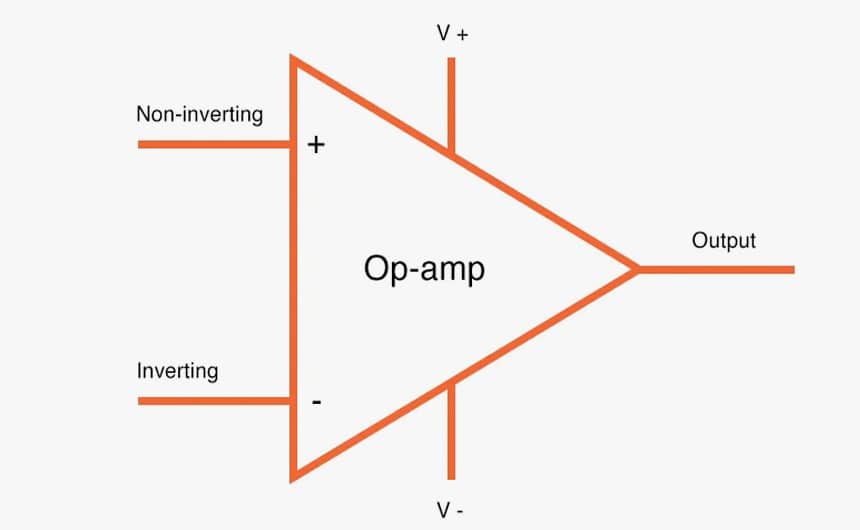
Amplifier operation can be classified as Class A, B, or AB.
The four tubes are placed in two sets of A-B operation tubes so that they add power to each “half” of the sine wave. This allows them to work like a single, more powerful tube. There are advantages and disadvantages to each of these common modes of operation.
Advantages
Disadvantages
Advantages
Disadvantages
There are other classes of amplifiers as well, such as Class G and Class H, but they are not used for audio applications.
Talking of Fender, the company still makes the best tube amps that professional musicians and music directors the world over favor. The Fender Pro Junior IV is an especially popular part of the “Hot Rod” series released in 1996. It features high-end, all-tube performance and is a highly portable unit with two speaker outputs and an 8-ohm primary tap. It is a vintage beauty with a warm buttery sound that you simply can’t resist.
Audio Tinker has a simplified schematic showing how everything comes together in a tube amplifier. If you are not familiar with the symbols, the labeling will help you figure things out.
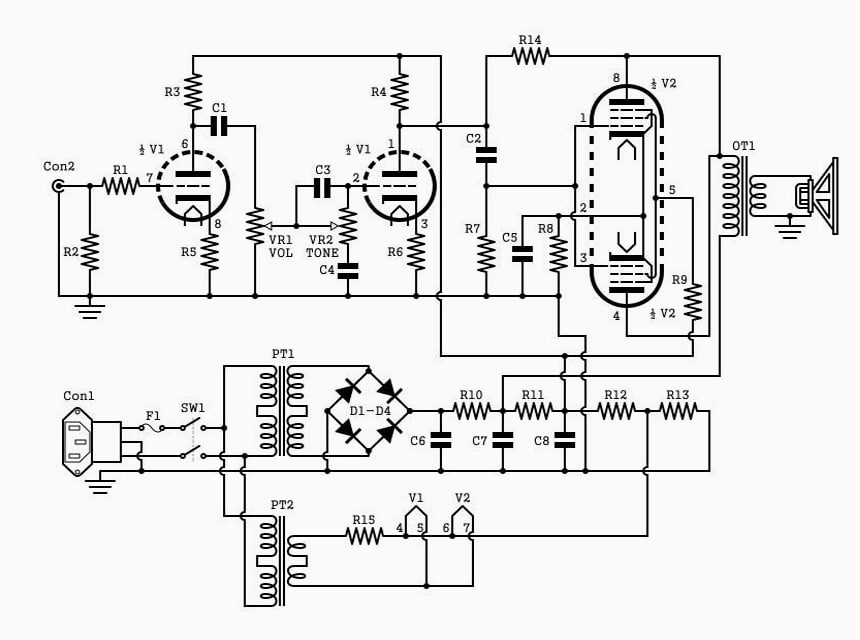
You can check out the full instructions on the AudioTinker website to learn more about the circuit, assembly, and specifics of the components used.
Now that you have a basic idea of how tube amps work, comparing their performance with that of solid-state amplifiers is important.
Solid-state amplifiers amplify signals using transistors and diodes. You would expect the more modern technology to produce better results, but that isn’t the case. Tube amps are warm and produce a pleasant, full-bodied result. In more technical terms, tube amps produce audile with a good bass and midrange response.
When you overload a tube amp, the effect is even more pronounced. They cause a distortion of sorts that makes the sound even better, especially when playing loud guitar music in genres like rock and roll. If you play heavy metal and rock, take a look at these top 8 amps for metal you can buy today.
In comparison, solid-state amps are more faithful to the original signal and produce a cleaner sound. Because they don’t need to be overloaded, they have more headroom (loudness without distortion), so they tend to be popular with bassists, keyboard players, and jazz.
An amplifier without natural harmonic distortion sounds unnatural, so some modern amps called modeling amps tend to mimic the sound of tube amps.
Tube Amps Advantages
Tube Amp Disadvantages
Solid-State Amps Advantages
Solid-State Amp Disadvantages
On paper, it would seem that solid-state amps beat tube amps squarely. However, the warm and mellow sound produced by tubes makes them worth all the extra expense and effort required to use them.
Today, most amps are actually hybrids of both technologies. They have a tube preamp stage to
Tubes require regular checking and swapping depending on the frequency of playing. That could be anything from 6-month intervals to a couple of years.
Vacuum tubes wear out naturally with time. They can simply burn out, or gas can form inside the tube, making them less effective. This causes them to become less effective. Here are some signs of bad tubes.
When you have a faulty valve, it is advisable to replace all of them at once. This ensures correct biasing and restores full performance. In case of failure, you should always have replacement valves with you because sometimes playing with a bad one can damage the other internal components.
This should be a problem, however. You can buy these Genalex premium preamp tubes for less than $50 a pop. They are designed to resist feedback and make a lively upgrade to your old tube amp and are some of the most popular 12AX7 preamp tubes out there.
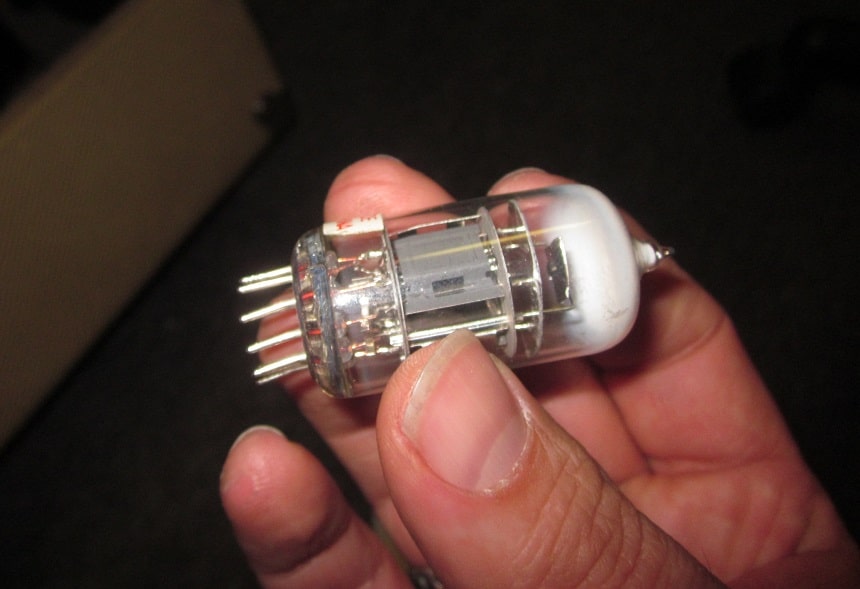
Once you have determined that you have a bad vacuum tube, the next step is to remove and replace your tubes following the recommended safety guidelines. In this case, the manufacturer’s instructions always take precedence, but here are a few pointers.
Yes, most manufacturers account for this in their design. The tubes are located outside the chassis with a different cover, and they won’t require rebiasing as long as you use recommended replacements.
The vacuum tubes in a tube amp generally last 5,000 to 10,000 hours of playtime. However, this depends on the intensity of use. The best way to know when it’s time for replacement is to check for any strange sounds or lag in performance.
Tube amps sound better than solid-state amps and any other alternative technology. Even without being a purist, you will hear the difference in the warmth and character of their sound compared to the cold, clean sound of solid-state amps.
Yes. Vacuum tubes wear out with use, so it is better to always turn off your amp when you are done using it. They also tend to overheat and use up a lot of power, so it is safer and cheaper to have them off until they are needed.
Despite the amazing sound that tube amps produce, the answer here is “no, not really.” The full character of tube amps only comes out when they are used to the max, which means in recording or performance sessions.
If you just need an amp for practice or move around a lot, a tube amp is not worth the money or effort required. You might want to check out our top five bass practice amps for this instead.
Yes, tube amps need about 20-30 minutes to warm up properly before you can start playing on them. Your manufacturer will have provided guidelines on this.
To take maximum advantage of overdrive, you should crank the volume on the amp all the way up and then use your guitar’s pickup controls to control the overall volume. This will give you maximum character even at relatively lower volumes.
Apart from replacing the tubes as needed, a good tube amp won’t need service or repair for 10 years or more. It is always advisable to buy high-quality tube amps from recognized manufacturers in the first place, such as Fender or Marshalls.
Century-old technology still trumps the most advanced transistor and microchip technology when it comes to amplifying guitar music. The natural harmonic distortion that tube amplifiers produce makes them worth all the effort required to maintain and use them.
Hopefully, now you understand how tube amps work from this simplified explanation. The amps themselves are so simple that you can build one yourself given the right parts, but the technology behind them is simply ingenious.
You can also now take better care of your old tube amp, and perhaps even perform a few minor upgrades to get the best sound. Remember to enjoy the mellow sound of these antiquated units before impostor technology sweeps them all to the graveyard.